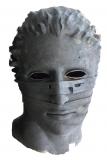Results 1 to 5 of 5
Thread: Measuring tolerances in STL
-
03-22-2016, 08:37 AM #1
 Measuring tolerances in STL
Measuring tolerances in STL
Hello, I have a question regarding measuring tools for STLs. I am talking about premade STLs and not made by me.
I have been working with 123D Design, Netfabb and Meshmixer for 3 months but none of those programs have a solution for measuring tolerances. Tried to split the model in different axis (X,Y,Z) but my eye isn't that accurate so that I can correctly estimate the tolerance.
Edit: I tried with the ruler but no success. If there is a way to use that please tell me how.
Let's say I have a cylinder inside a hole and it has space so that the cylinder can move freely inside that hole.
How can I measure the space from the cylinder face to the inside of the hole?
Edit#2: Just done it with NetFabb Ruler.
Delete topic pls.Last edited by Horia; 03-22-2016 at 09:02 AM.
-
03-22-2016, 09:52 AM #2
Hi,
I don't know what you think you're measuring in Netfabb but given that a STL is a polygon approximation of your original design intent... a tolerance is kinda meaningless. The tolerance enters into account when you do the export to stl format : at that time you can select the authorized deviation range from actual design to polygon approximation.
-
03-22-2016, 10:14 AM #3
Thanks for information but I was talking about STL-s that are already combined and optimized for 3d printing (like downloaded from thingiverse).
In Netfabb there is a button called "ruler". It allows me to measure distance from point to point from the surface of the object.
This is what I was talking about
https://drive.google.com/file/d/0B0w...ew?usp=sharingLast edited by Horia; 03-22-2016 at 10:28 AM. Reason: inserted picture
-
03-25-2016, 09:27 AM #4Student

- Join Date
- Sep 2014
- Posts
- 3
Horia: I would suggest to measure the distance of the gap, or hole. Then measure the distance of the part that is going to be inserted into that hole. Then do math. Divide both by 2 then subtract. That will give you the remaining distance that is considered the "play" of the parts.
So looking at your image... Say the hole that the cylinder goes into is 10 mm, and the cylinder is 9.8 mm. This means that there will be 0.1 mm of play on either side of the cylinder.
Then you have to take into account the tolerance of your printer. If your printer is consistently putting out larger parts... chances are that the cylinder will fuse to the hole. If it produces consistently smaller parts... you should be fine.
-
03-25-2016, 09:32 AM #5
I printed the model and 0.4 is an ok tolerance so that the joint moves freely. I use 0.2 tolerance for interconnecting non-moving parts






 Reply With Quote
Reply With Quote




Extruder not feeding during print,...
Today, 02:02 PM in Tips, Tricks and Tech Help